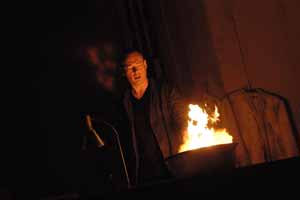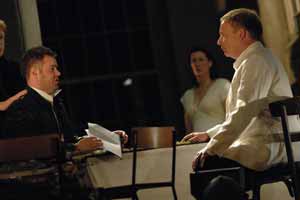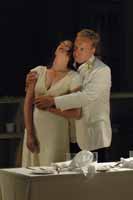Glyndebourne Festival Opera
27th July
 Staging oratorio is now so regular a feature of our music-theatre experience that it did not at first seem strange that Glyndebourne was to stage the St Matthew Passion. However, where Handel's late oratorios are highly charged dramatic narratives with a wide range of emotion, Bach's Passions are essentially reflective and introspective works throughout. Katie Mitchell's production approaches this problem head on by severely limiting not only the action but also the emotional range available to the performers.
Staging oratorio is now so regular a feature of our music-theatre experience that it did not at first seem strange that Glyndebourne was to stage the St Matthew Passion. However, where Handel's late oratorios are highly charged dramatic narratives with a wide range of emotion, Bach's Passions are essentially reflective and introspective works throughout. Katie Mitchell's production approaches this problem head on by severely limiting not only the action but also the emotional range available to the performers.
Readers familiar with the works of David Lynch or Peter Greenaway will feel a sense of familiarity with the anonymous school room, the groups of unidentified individuals and the lack of any willingness to try to explain what is happening. Instead we are dropped in medias res and have to work hard to begin to make sense not only of what is happening on stage but equally of its relationship to the music we are hearing.
It is not an easy evening but I found it highly effective and stimulating. It raises large numbers of questions about our current cultural relationships to death, loss and grieving while refusing to give easy answers. It also gives the Passion story a relevance it can too easily lose within a conventional concert performance. Katie Mitchell treats the story as a folk myth which, like the stories of Orpheus or Adonis, have deep psychological significance which goes far beyond the trappings of religion.
It helps to explain the continuing attraction of the Passion settings in a world which has abandoned church attendance and rote belief.

There are however times when the production goes too far. The use of the child with angel's wings towards the end is surely psychologically impossible if we are to accept that all those on stage have lost their own children. Though it gives a rare moment of hope it would surely be devastatingly bleak for most of those so recently bereaved.
 There is also, surprisingly, a problem with the placement of the chorus. Too often the choral sound was unclear and unfocussed simply because they were bunched together and could not sing out. In a theatre production this would have been fine but singers need to be aware of the conductor and have room for their voices to reach the audience.
There is also, surprisingly, a problem with the placement of the chorus. Too often the choral sound was unclear and unfocussed simply because they were bunched together and could not sing out. In a theatre production this would have been fine but singers need to be aware of the conductor and have room for their voices to reach the audience.
No problems with the soloists led by a superbly sung Evangelist from Mark Padmore. Looking like a touring director himself, he effortlessly moves on the presentation of the Passion while implying that this really is being improvised on the spot. He is finely supported by Ingela Bohlin and Sarah Connolly – the female soloists – and Henry Waddington as Christ. But perhaps the most compelling performances came from Andrew Tortise as the tormented tenor soloist, and the avuncular bass of Christopher Purves. As the evening slowly progressed it was these two characters who grew in stature and complexity, showing a range of emotion and understanding which was unavailable to the other soloists. Andrew Tortise's solo arias were the most moving moments of the whole performance and it was Henry Waddington who drew the community together at the end rather than the story tellers.
Richard Egarr just about managed to keep control of his forces both on stage and in the pit but the sound was not a vital as one would get in the concert hall or church.
Perhaps, when it comes down to it, this is one work which really does belong in the concert hall.
BH
